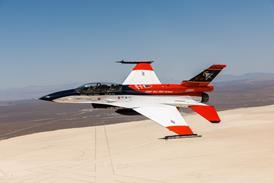The long-standing links between motorsport and aerospace will be celebrated at Farnborough with a dedicated pavilion to promote cross-fertilisation between the two industries.
The move is the first step of a UK government-funded "Motorsport to Aerospace" technology transfer venture. The "Motorsport Valley Pavilion" is designed to allow motorsport companies to present their products and services to aerospace buyers. It is the first time that non-aerospace businesses have exhibited at the show.
The Government Motorsport Unit has been created by the UK Department of Trade and Industry to allocate £16 million ($29.3 million) over a five-year period to develop UK motorsport.
The UK's Motorsport Industry Association (MIA) has implemented the programme, with support from the Society of British Aerospace Companies. The MIA says that future elements will include provision of consultancy support services, workshops, and a trade mission to next year's Paris air show.
Demonstrations will be carried out on Farnborough's runway of various high-performance vehicles, while static displays in the pavilion will include the British American Racing Honda Formula 1 (F1) car, in which Jenson Button and Takuma Sato have recently been having so much success.
MG Rover Group will demonstrate its 765bhp MG ZT-T, which reached a top speed of 360.9km/h (225.6mph) last year on the Salt Flats in Utah, USA, claiming the title of world's fastest estate car. The turbine-powered Fireforce 2 jet car - powered by a reheat equipped 5,000lb-thrust (22.3kN) Pratt & Whitney JFTD12 engine from a Sikorsky CH-54 Skycrane helicopter - will display its capabilities. The reheated engine gives the Chevrolet-bodied machine an equivalent of 10,000bhp, enabling it to sprint across 800m (0.5 miles) in less than 6s and achieve a maximum speed of 400km/h. A Team Jota endurance sports car, which competed in last year's Le Mans series and which was developed in partnership with science and technology specialist Qinetiq, will also show off its performance.
The UK has long been the world's centre of excellence for motorsport at its highest level, boasting championship-winning F1 teams like Lotus, McLaren and Williams. The campaign to encourage technology transfer between these two sectors within the UK was conceived by the MIA, and launched in November 2002 by science minister Lord Sainsbury, who said that the aim was "to create the best possible environment for innovation, helping these leading industries to consolidate their position as key players in the competitive global market".
The MIA says that the plan behind the pavilion is to enable motorsport companies to market their technologies to a global aerospace audience; attract highly qualified employees; find new suppliers; and discover new engineering innovations that have an application in modern motorsport.
Boeing Phantom Works prototype centre director James Ogonowski expects the initiative will provide a useful opportunity for the two sectors to interact: "We both require high performance from our products, the latest materials and engineering to extract performance to produce 'vehicles' that are not made in large numbers."
The two key cross-over areas are aerodynamics and structures - and the need for highly skilled people from both disciplines has seen engineers lured from aerospace into the more "sexy" and highly paid world of motorsport. At least two key personnel in today's leading F1 teams arrived from aerospace. McLaren-Mercedes managing director Martin Whitmarsh was recruited from British Aerospace in 1989, while Toyota F1 team technical director Mike Gascoyne began his career at Westland Helicopters.
MAX KINGSLEY-JONES / LONDON
Source: Flight International
















